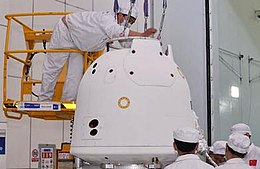Chang'e 5-T1

Chang'e 5-T1's re-entry module after vacuum thermal tests
|
|
| Mission type | Chang'e 5 precursor mission, lunar flyby and Earth reentry |
|---|---|
| Operator | CNSA |
| COSPAR ID | 2014-065A |
| SATCAT no. | 40283 |
| Mission duration | Primary Mission: 8.17 days Extended Mission: 930 days |
| Spacecraft properties | |
| Bus | DFH-3A |
| Manufacturer | CAST |
| Start of mission | |
| Launch date | 23 October 2014, 18:00 UTC |
| Rocket | Long March 3C/G2 |
| Launch site | Xichang LC-2 |
| End of mission | |
| Landing date | 31 October 2014, 22:42 UTC Return capsule |
| Landing site | Siziwang Banner, Inner Mongolia |
| Orbital parameters | |
| Reference system | Geocentric |
| Regime | Lunar free return |
|
|
|
Chang'e 5-T1 (Chinese: 嫦娥五号T1; pinyin: Cháng'é wǔhào T1) is an experimental unmanned lunar mission that was launched on 23 October 2014 by the China National Space Administration (CNSA) to conduct atmospheric re-entry tests on the capsule design planned to be used in the Chang'e 5 mission. As the final part of the Chinese Lunar Exploration Program, Chang'e 5, scheduled for 2017, will be a Moon sample return mission. Like its predecessors, the spacecraft is named after the Chinese Moon goddess Chang'e.
It consisted of a DFH-3A "Chang'e 2 type" spacecraft featuring the Chang'e 5 return capsule, launched by a Long March 3C rocket into a lunar free return trajectory. It looped behind the Moon and returned to Earth, with the return capsule testing the high speed atmospheric skip reentry. The DFH-3A "service module" remained in orbit around the Earth before being relocated via Earth-Moon L2 to lunar orbit by 13 January 2015, where it will use its remaining 800 kg of fuel to test maneuvers key to future lunar missions.
In February and March the DFH-3A "service module" will perform 2 "virtual target" rendezvous tests for the future CE-5 mission. In April 2015 the small monitoring camera will be used to obtain higher resolution photos of CE-5's landing zone.
Chang'e 5-T1 also carries the first commercial mission to the moon called the 4M mission (Manfred Memorial Moon Mission) for the German space technology company, OHB System, in honor of the company's founder, Professor Manfred Fuchs, who died in 2014. Technical management of the 4M mission was performed by LuxSpace. The payload weighs 14 kilograms and contains two scientific instruments. The first instrument is a radio beacon to test a new approach for locating spacecraft. Amateur radio operators were encouraged via prize incentives to receive the transmissions and send results back to LuxSpace. The second instrument, a radiation dosimeter provided by the Spanish company iC-Málaga, continuously measured radiation levels throughout the satellite's circumlunar path.
...
Wikipedia
